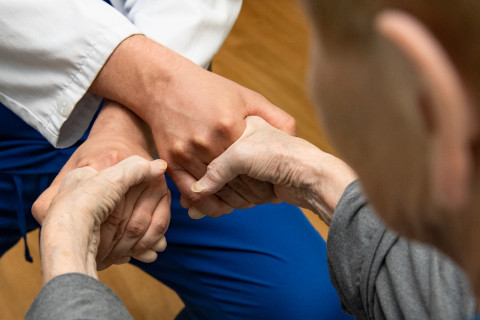Two neuroscience research projects coordinated by the University of Eastern Finland have secured significant funding from the EU’s JPND programme. A project led by Professor Tarja Malm explores the mechanisms underlying the use of focused ultrasound to prevent or slow down the progression of Alzheimer’s disease. Associate Professor Alina Solomon leads a project examining the short- and long-term mechanisms of multimodal interventions to prevent dementia.
JPND projects are funded in collaboration between national funders and the European Union. In Finland, funding is granted by the Academy of Finland.
Focused ultrasound combined with pharmacotherapy to enhance beta-amyloid clearance
Focused ultrasound (FUS) is a non-invasive, ground-breaking brain stimulation technique suggested for the treatment of Alzheimer’s disease. FUS promotes transient opening of the blood-brain barrier and enhances the microglial-mediated clearance of beta-amyloid typically accumulating in the brain in Alzheimer’s disease. However, the molecular mechanisms underlying these beneficial effects are poorly known, which limits the full translation of FUS into the therapeutic arena.
The REBALANCE project coordinated by Professor Tarja Malm at the A. I. Virtanen Institute for Molecular Sciences aims to discover the key cellular targets and molecular mechanisms underlying FUS-induced brain cleaning and therapeutic efficacy in Alzheimer’s disease. The project partners have previously demonstrated therapeutic efficacy for FUS stimulation alone and combined with microbubbles.
“We hypothesise that FUS, through the activation of mechanosensitive Piezo1 channels, enhances beta-amyloid clearance by microglial cells and facilitates the removal of waste from the brain into the blood stream. This occurs through the improvement of glymphatic flow together with transient increase in the blood-brain barrier permeability. Moreover, increased blood-brain barrier permeability enables drug delivery into the brain, further boosting beta-amyloid clearance,” Malm says. The researchers will mechanistically link the cellular players and intracellular pathways responsible for the increase in blood-brain barrier permeability, microglia-mediated beta-amyloid clearance and glymphatic flow. These efforts are expected to lead to an efficient clinical translation of the preclinical findings and towards more efficient treatment of patients with Alzheimer’s disease.
The partners in the REBALANCE project are Associate Professors Meaghan O’Reilly from the University of Toronto in Canada and Mežinska Signe from the University of Latvia, as well as Professors Michael Heneka from the University of Luxembourg, Arn Maagdenberg from Leiden University Medical Centre in the Netherlands, and Denis Vivien from INSERM and the National Research Agency ANR in France. The overall budget of the project amounts to 1.86 million euros.
Multiple mechanisms are involved in dementia development and prevention
Dementia pathogenesis is complex and multifactorial, with abnormalities in multiple cellular and molecular pathways resulting from interactions between several risk factors. Many risk factors are modifiable, but interventions focusing on only one or few of them have not produced a sustained clinically relevant benefit. However, this could be improved via a multimodal approach targeting more risk factors simultaneously.
Several multinational multimodal human trials have already demonstrated long-term cognitive and functional benefits across the entire continuum from at-risk to prodromal disease stages. The Multi-MeMo project coordinated by Associate Professor Alina Solomon at the Institute of Clinical Medicine combines this data with experimental molecular, cellular, and animal models to study the mechanisms behind the beneficial effects.
“We hypothesise that multimodal interventions may exert their effects via a combination of synergistic mechanisms, possibly amyloid and tau-related, but likely also unrelated or only indirectly related to classical Alzheimer’s disease mechanisms,” Solomon says.
These mechanisms could involve synaptic plasticity, inflammatory-immune responses, glucose and lipid homeostasis, bioenergetic metabolism, neurotrophic factors, insulin signalling, vascular function, stress hormone level alteration, and oxidative stress.
The researchers aim to identify the mechanistic basis for multimodal preventive interventions with experimental molecular, cellular and animal models mirroring the human non-pharmacological trial design and interventions. The results will be validated with samples and clinical data from human trials. In addition, the project will investigate the effective time window for different types of interventions and identify personalised predictors of shorter and longer term intervention response within the follow-up data of up to 11 years. Psychological and social aspects among the participants will also be studied.
The project is expected to produce an enhanced, mechanistically driven multimodal intervention model where pharmacological and non-pharmacological modalities enhance each other’s effects. The results will ultimately lead to timely, personalised interventions to effectively prevent or delay dementia onset.
The partners in the Multi-MeMo project are Professor Tobias Hartmann from Saarland University in Germany, Professor Wiesje van der Flier from Amsterdam University Medical Centers in the Netherlands, Research Director Rafael de la Torre Fornell from Hospital del Mar Medical Research Institute in Spain, Petr Novak from the Slovak Academy of Sciences and Executive Director Jean Georges from Alzheimer Europe in Luxembourg.
The overall budget of the project is 1.69 million euros.
These research groups are members of the multidisciplinary Neuroscience Research Community (NEURO RC) at the University of Eastern Finland. NEURO RC aims to understand the disease-specific and common molecular mechanisms underlying neurodegenerative diseases and epilepsy and to identify novel biomarkers and therapeutic approaches for their prevention and cure. Comprising 17 research groups, NEURO RC integrates biological neurosciences with data sciences, neuro-innovations, and neuro-ethics. Learn more and connect with NEURO RC:
Website
Twitter





